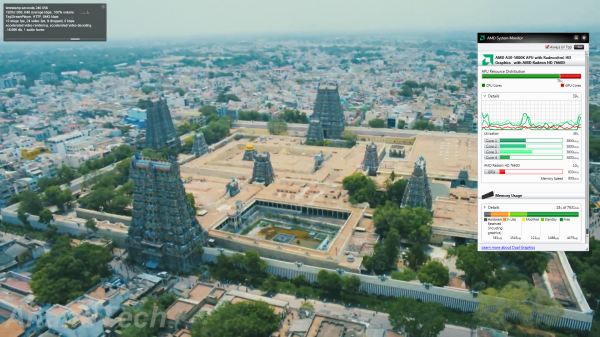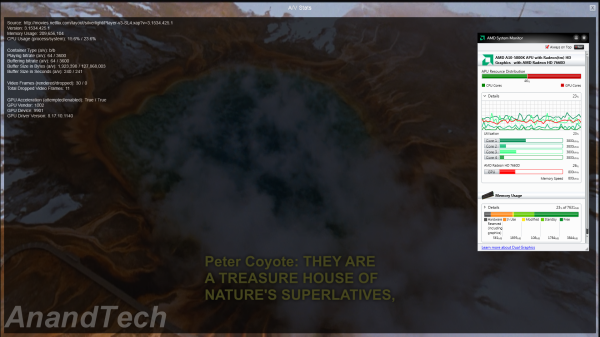AMD's Trinity : An HTPC Perspective
by Ganesh T S on September 27, 2012 11:00 AM ESTFlash acceleration has traditionally worked without issues in AMD and NVIDIA drivers, unlike Intel. Intel and Adobe got it right with Ivy Bridge. Fortunately, things look good with Trinity too. As the screenshot below indicates, we have full GPU acceleration for both decoding and rendering. AMD's System Monitor shows how the CPU and GPU resources are balanced when playing H.264 Flash videos.
Netflix streaming, on the other hand, uses Microsoft's Silverlight technology. Unlike Flash, hardware acceleration for the video decode process is not controlled by the user. It is up to the server side code to attempt GPU acceleration. Thankfully, Netflix does try to take advantage of the GPU's capabilities.
This is evident from the A/V stats recorded while streaming a Netflix HD video at the maximum possible bitrate of 3.7 Mbps. The high GPU usage in the AMD System Monitor also points to hardware acceleration being utilized.
One point which deserves mention here is that Flash and Silverlight acceleration works without hiccups here, unlike what we saw in the Brazos-based machines (where the CPU was too weak despite the availability of hardware acceleration through the GPU).












49 Comments
View All Comments
Marlin1975 - Thursday, September 27, 2012 - link
Later, when you hace access, can you do the same test with the lower end dual core 65watt Trinity?I think that would be the best HTPC Trinity if it also keeps up.
But looks good for a HTPC/Light gaming rig.
coder543 - Thursday, September 27, 2012 - link
gotta agree. The A10 would not be my choice of processor for an HTPC. I would go with something lower cost and lower wattage... but maybe other people enjoy transcoding videos on their HTPCs.ddrum2000 - Thursday, September 27, 2012 - link
I partially disagree (personal preference). I'd like to the 65W A10-5700 reviewed as opposed to the A10-5800K since a 65W part makes much more sense for an HTPC then a 100W part. By extention, the A8-5500 would be interesting as well though I'm curious how much of a difference the number of Radeon cores makes in terms of HTPC usage.coder543 - Thursday, September 27, 2012 - link
that's what we said. how do you disagree?Silent Rage - Thursday, September 27, 2012 - link
You said, "The A10 would not be my choice of processor for an HTPC."He said, "I'd like to the 65W A10-5700 reviewed as opposed to the A10-5800K since a 65W part makes much more sense for an HTPC then a 100W", hence the partial disagreement.
MonkeyPaw - Thursday, September 27, 2012 - link
I transcode on my HTPC, but I just use Quicksync on my i3 with HD 3000 graphics. I use Arcsoft media converter 7 and rip HD TV recordings down to a manageable size to play on my Iconia tablet. Considering the fact that it only takes 20-30 minutes to take a 1080p show down to 720p at 1/6 the original file size, I can't complain about the results. Intel offers an HD 4000 i3, and that would be my HTPC CPU of choice if I had to buy today.Arbie - Thursday, September 27, 2012 - link
The features you are testing are never obvious from a spec sheet, so a targeted hands-on review like this is very important. At least it is to me, because my next laptop choice will be based on its capabilities for media viewing and gaming. And battery life, followed by weight.Thanks!
coder543 - Thursday, September 27, 2012 - link
this was a desktop review. The Trinity mobile reviews happened months ago..stimudent - Sunday, September 30, 2012 - link
I'm glad that Anandtech has explained to us that this is a staged released and has offered its review based around that by looking to past performance. This is better reporting. Not the immature biased reporting being done by Tech Report.If Intel did this, it's almost a sure thing TechReport.com would not have said a thing about a staged release and gone ahead with its review the same way Anantech did here.
ChronoReverse - Thursday, September 27, 2012 - link
Isn't giving you 23.977 what you'd actually want over 23Hz? I can't think of when you'd want 23Hz (whereas 24Hz, 25Hz and 30Hz are all useful) whereas 23.976 is what you'd want from telecined material.